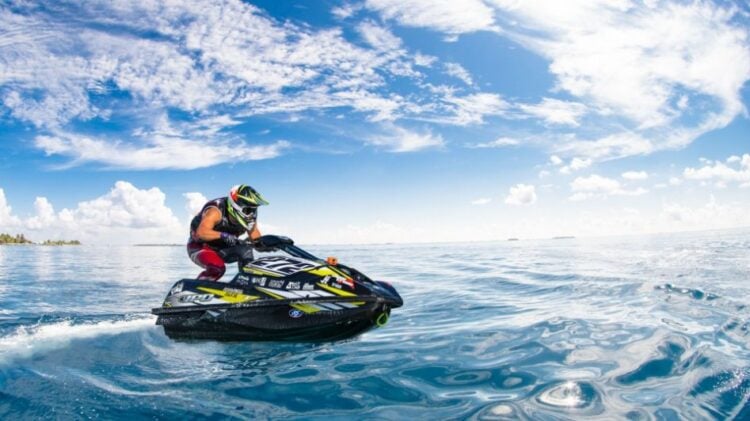
OBJECTIVE OF JET SKI RACING: Be the first to cross the finish line after completing a specified number of laps of a water-based course.
NUMBER OF PLAYERS: 2+ players
MATERIALS: Jet ski, flotation vest, helmet
TYPE OF GAME: Sport
AUDIENCE: 11+
OVERVIEW OF JET SKI RACING
Jet ski racing, also referred to as “aquabike racing”, is a water sport that involves competitors using engine-propelled jet skis to race around a course at very high speeds. Unlike many other powerboats, jet skis are classified as “personal watercraft” (PWC), which can be defined as any jet-driven vessel in which someone sits or stands on, as opposed to in (like a boat). Because of this fact, jet skis are incredibly small compared to other watercraft (usually only 10 feet in length), all the while still sporting a very powerful engine and great maneuverability.
The first jet ski was invented in the United Kingdom in the 1950s. At that time, they were known as “water scooters” and were often marketed as propelled surfboards that could reach speeds up to 25 miles per hour. Over the next 20 years, many people from around the world would create their own PWC prototypes. This included changing the motor type, handle positions, the orientation of the driver, and much more.
It wasn’t until 1972 that the Japanese company Kawasaki produced sit-down and stand-up PWCs designed for only a single rider. These were sold under the brand name “Jet Ski”, a name which has since become synonymous with most small personal watercraft.
As a competitive sport, jet ski races have been held as far back as 1996 with the inaugural Aquabike World Finals Championships. Hundreds or more riders from over 30 nations compete in this competition sanctioned by the World Powerboating Federation, an organization that is formally recognized by the International Olympic Committee. Despite this recognition, powerboating sports were only ever part of the 1908 Olympic Games (in which jet skis clearly didn’t yet exist), and there are no plans for its return.
SETUP
EQUIPMENT

- Jet Ski: Small yet extremely powerful, quick, and maneuverable watercraft that a rider sits or stands on in a manner that closely resembles how one would on an ATV (all-terrain vehicle). Jet skis are generally 10 or 11 feet long and have, on average, 100 to 150 horsepower engines.
- Flotation Vest: As with all watersports that take place on open waters, all participants should wear a life jacket or other flotation device in case of emergency.
- Helmet: Due to the high speeds that jet skis can achieve, helmets are warranted for both safety and visibility purposes (wind, sun, water, etc.). These helmets feature a face shield and an aerodynamic design similar to that of a motorcycle helmet.
EVENTS
There are two main types of jet ski races: closed-circuit events and offshore events.
1) Closed-circuit racing series often take place on lake-based courses that are outlined by a number of buoys that riders must go around. No two courses are the same, although many feature simplistic oval-shaped designs and require competitors to complete multiple laps. In most of these races, groups of 8 to 10 riders compete in each heat.
Jet Ski World Finals IJSBA 2020
2) Offshore races are held offshore on the open ocean. These events are usually point-to-point endurance races that require riders to race to a location that can be more than 500 miles away from the starting line.
2016 Long Beach To Catalina & Back Offshore Endurance National Championship
Additionally, there are also freestyle events that take place in some competitions, which involve individual riders performing various stunts with their jet skis to impress a panel of judges.
GAMEPLAY

As with all races, jet ski races are decided by the order in which riders cross the finish line. Depending on the event, some races may require riders to be separated into heats of 8 to 10 riders. In these cases, a certain number of the top finishers in each heat move on to the next (or final) round to compete in another winner-takes-all race.
HOW FAST DO JET SKIS GO?
Most jet skis can travel at around 45-60 miles per hour. The fastest jet ski in the world is The Supermarine MM01 Hyperjet, which can travel at speeds of over 75 mph! That can get you across the English Channel in about 15 minutes!
SNOWMOBILE SKIPPING
Also known as “snowmobile watercross”, snowmobile skipping is essentially jet ski racing with snowmobiles. Since snowmobiles are clearly designed for land travel and do not function as a boat, they actually sink while in water. However, due to their wide tracks, they can actually skim over water if traveling at a threshold speed (5 mph per 150 pounds of weight).
Although many people are unwilling to participate in these races because of the high risk of their expensive snowmobiles sinking, the World Championship Snowmobile Watercross has been held every year in Grantsburg, Wisconsin, since 1977! And, even if a snowmobile does sink, it is possible to “revive” it by pulling it out of the water, replacing the fuel, and draining water from the carburetor, spark plugs, and exhaust.
END OF GAME
All jet skiing races are won by the jet skiers who are first to cross the finish line of the final race after completing a set number of laps.
- 30 GAMES TO PLAY OVER TEXT - April 22, 2024
- 20+ FREE PRINTABLE BABY SHOWER GAMES - April 16, 2024
- 20+ College Party Games for the Best Night Ever! - April 2, 2024